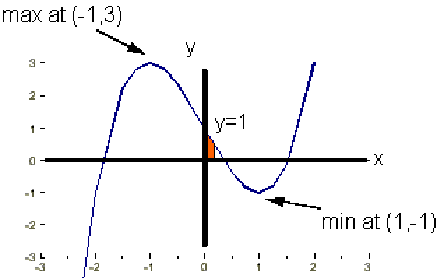1) Determine the following:
a) dy/dx if y = 15x4 b) dy/dh if y = h12 + 9h2 - 7
c) dy/dx if y = -7 ln x d)
dp/dr if p = 3![]() 104 e-2r (4 marks)
104 e-2r (4 marks)
2) Differentiate the following functions with respect to x, and simplify the result where possible:

3) Consider the function y(x) = x3 -3x + 1.
a) Determine the co-ordinates (x, y) of the stationary point(s) of this function. (4 Marks)
b) Do the stationary point(s) you have just found correspond to local maxima, minima, or point(s) of inflection? (4 Marks)
c) Hence sketch this function between x = -3 and x = +2. (3 marks)
d) What is the area beneath this curve between x = 0 and x = 0.25 ? (3 marks)
1) [1 mark each].
a) dy/dx = 60x3
b) dy/dh = 12h11 + 18h
c) dy/dx = -7 / x
d) dp/dr = -6![]() 104e-2r
104e-2r
2) [2 marks each].
a) Product Rule: (2x + 3).3 + (3x - 1).2 = 12x + 7
b) Quotient Rule:  =
= 
c) Function of a Function:  =
= 
3a) y(x) = x3 - 3x + 1
dy/dx = 3x2 - 3,
which must equal zero at the t.p.s. Thus, they occur at:
3x2 - 3 = 0, i.e. at x = -1 and +1.
So the stationary points are at (-1,3) and (1,-1).
b) d2y/dx2 = 6x
At stationary point (-1,3), x = -1, so d2y/dx2 = -6, so it's a maximum.
At stationary point (1,-1), x = +1, so d2y/dx2 = +6, so it's a minimum.
(c) 3 marks if have shape correct, axis labels correct, have labelled the t.p.s and the intercept at y = 1.
so the curve looks like:

The intercepts on the x axis are not simple to calculate, and so haven't been shown.
d) 3 marks. The area is shown in orange in the plot above.Area = 
Area = 
Area = (1/1024 - 3/32 +1/4) - (0)
Area = 0.157 sq. units